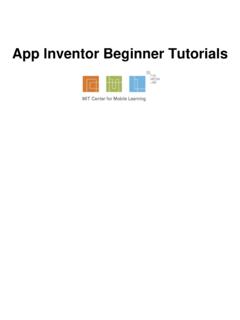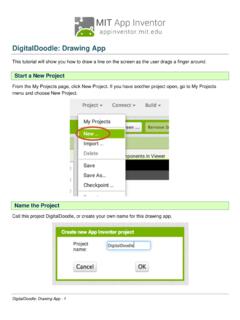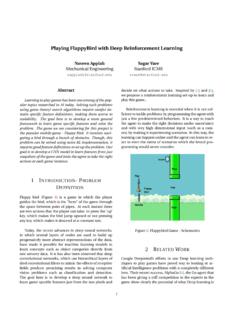Transcription of BallBounce: A simple game app
1 BallBounce: A simple game appIn this tutorial, you will learn about animation in App Inventor by making a Ball (a sprite) bounce aroundon the screen (on a Canvas).Start a New ProjectIf you have another project open, go to My Projects menu and choose New : A simple game app - 1 Name the ProjectCall it something like "BallBounce". Remember, no spaces. But underscores are a CanvasFrom the Drawing and Animation drawer, drag out a Canvas component and drop it onto the : A simple game app - 2 Set the Screen so that it does not scrollThe default setting for App Inventor is that the screen of your app will be "scrollable", which means thatthe user interface can go beyond the limit of the screen and the user can scroll down by swiping theirfinger (like scrolling on a web page).
2 When you are using a Canvas, you have to turn off the"Scrollable" setting (UNCHECK THE BOX) so that the screen does not scroll. This will allow you tomake the Canvas to fill up the whole : A simple game app - 3 Change the Height and Width of the Canvas to Fill ParentMake sure the Canvas component is selected (#1) so that its properties show up in the Properties Pane(#2). Down at the bottom, set the Height property to "Fill Parent". Do the same with the : A simple game app - 4 Add a BallNow that we have a Canvas in place, we can add a Ball Sprite. This can also be found in the Drawingand Animation drawer. Drag out a Ball component and drop it onto the Canvas (#1). If you'd like theball to show up better, you can change its Radius property in the Properties pane (#2).Open the Blocks : A simple game app - 5 Open the Ball1 Drawer to view the Ball's out the Flung Event HandlerChoose the block when and drag-and-drop it onto the workspace.
3 Flung refers to the usermaking a "Fling gesture" with his/her finger to "fling" the ball. Fling is a gesture like what a golf clubdoes, not like how you launch Angry Birds! In App Inventor, the event handler for that type of gesture iscalled when : A simple game app - 6 Set the Ball's Heading and Speed. First get the setter the Ball drawer and scroll down in the list of blocks to get the set and blocksBallBounce: A simple game app - 7 Plug the set and set into the Fling event handlerSet the Ball's speed to be the same as the Fling gesture's speedMouse over the "speed" parameter of the when event handler. The get and set blocks forthe speed of the fling will pop up. Grab the get speed block and plug that into the set : A simple game app - 8 Set the Ball's heading to be the same as the Fling gesture's headingDo the same for the Ball's heading.
4 Mouse over the heading parameter and you'll see the get heading block appear. Grab that block, and click it into the set : A simple game app - 9 Test it outA good habit while building apps is to test while you build. App Inventor lets you do this easily becauseyou can have a live connection between your phone (or emulator) and the App Inventor developmentenvironment. If you don't have a phone (or emulator) connected, go to the connection instructions andthen come back to this tutorial. (Connection instructions are in Tutorial #1 or on the website under"Getting Started".)Why does the Ball get stuck on the side of the screen?!After flinging your ball across the screen, you probably noticed that it got stuck on the side. This isbecause the ball's heading has not changed even though it hit the side of the canvas.
5 To make the ball"bounce" of the edge of the screen, we can program in a new event handler called "When EdgeReached".BallBounce: A simple game app - 10 Add an Edge Reached EventGo into the Ball1 drawer and pull out a when do : A simple game app - 11Go back into the Ball1 drawer and pull out a the edge value for the blockThe method needs an edge argument. Notice that the event has an"edge" as a parameter. We can take the get edge block from that argument and plug it into the call method. Grab the get edge block by mousing over (hover your mouse pointer over) the"edge" parameter on the when : A simple game app - 12 Your final blocks should look like this. Now test it out!BallBounce: A simple game app - 13 Test it out!Now, when you fling the ball, it should bounce off the edges of the canvas.
6 Great job!There are many ways to extend this are some but the possibilities are endless!- Change the color of the ball based on how fast it is moving or which edge it Scale the speed of the ball so that it slows down and stops after it gets Give the ball obstacles or targets to hit- Introduce a paddle for intercepting the ball, like a Pong gameVisit the App Inventor website to find tutorials that help you extend this app, particularly the Mini Golftutorial. Have fun with these extensions, or others that you think up!BallBounce: A simple game app - 14





